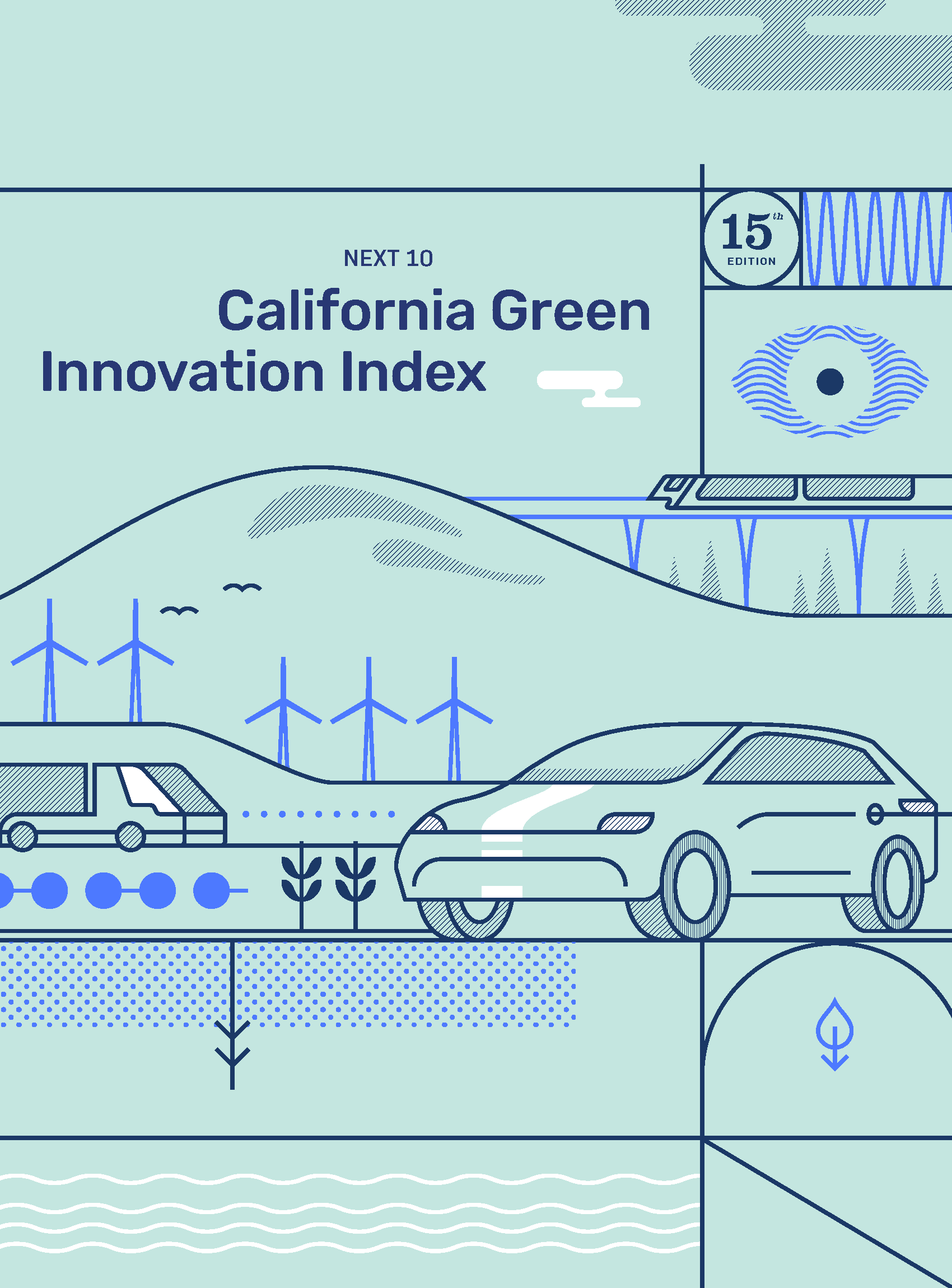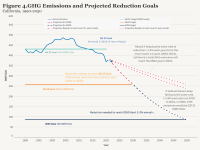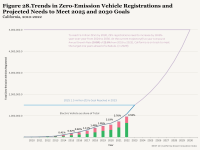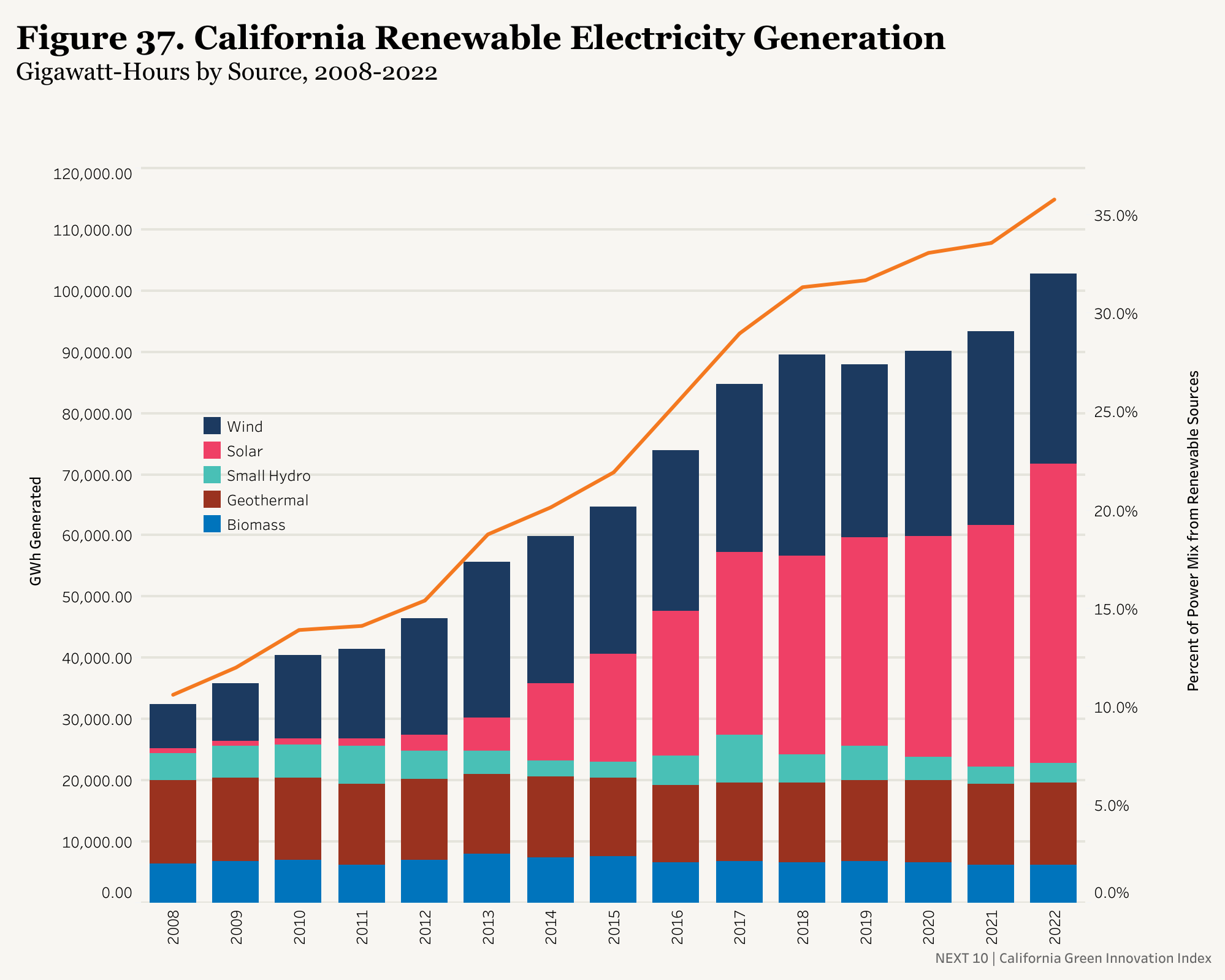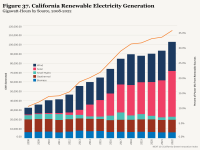Publications
2023 California Green Innovation Index
The 15th annual California Green Innovation Index is primarily digital, allowing readers to learn and interact with the findings of the report in an interactive medium. New this year, interactive charts allow readers to dive even deeper into the data. To get the full experience of the report's findings, visit the California Green Innovation Index website.
The report finds total greenhouse gas emissions rebounded between 2020 and 2021, jumping by 3.4 percent to 381.3 million metric tons of carbon dioxide equivalent (MMTCO2e) in 2021. This increase followed an 8.8 percent drop in emissions in 2020 due to the COVID-19 pandemic. However, most of the increase in emissions came from the transportation sector, which increased by 7.4 percent, driven by a 10.6 percent increase in emissions from passenger vehicles sub-sector. However, emissions from heavy-duty vehicles declined for the third consecutive year, resulting in 14.1 percent reduction in 2021 compared to 2018.
Within the transportation sector, new light-duty electric vehicle sales in all classes rose by 61.7 percent in 2022 compared to the previous year and California met the 2025 goal of 1.5 million zero-emission vehicles (ZEVs) on-road two years early in April 2023. The Index’s encouraging data on electric vehicle sales contrasts sharply with its findings on public transit ridership, which remained 40 percent below the pre-pandemic 2019 level in 2022, despite a 28.1 percent increase in ridership from 2021 to 2022.
To meet the 2030 target of nearly 260 MMTCO2e, California would need to triple the rate at which it has been cutting emissions since 2010—going from the actual average annual reduction of about 1.5 percent a year to about 4.4 percent a year. This is up from the 3.6 percent needed in 2020 (due to the large drop in emissions due to COVID) and the 4.2 percent needed in 2019. Even in more recent years, California’s emissions decreased by only 1.6 percent on average per year from 2016 to 2021—much less than the rate needed to meet the 2030 goal. Using the trajectory in emissions since 2010, California won’t meet the 2030 goal until 2047.
Among the other economic sectors, emissions from electric power generation have also increased in recent years—a worrying indicator after years of reliable decreases. From 2019 to 2021, emissions grew by 3.5 percent—the largest increase of any sector over that time period. Despite the recent increase, emissions have fallen by 40.5 percent since 2000 and by 12 percent since 2016. The rise in emissions from in-state generation of electricity (+10.3%) is likely due in part to summer heat waves and a lack of robust renewable energy growth in recent years. Additionally, California's once-held advantage of having a lower average residential electricity bill compared to the rest of the U.S. vanished in the wake of the pandemic. In 2011, the margin stood at 15.9 percent below the national average, but as of 2021, it had shifted to 2.2 percent higher than the U.S. average.
Growth in the amount of renewable energy being generated in California has slowed considerably since 2018— it increased by only 2.2 percent in absolute terms (6.6% in relative terms) to 35.8 percent of California’s total power mix (imports and in-state, but excluding large hydro) from 2021 to 2022. To meet the 2026 goal of 50 percent of generation from RPS-eligible renewable sources, California’s share of electricity generation from renewables would need to increase by 8.7 percent each year from 2022 to 2026, revised upward from 8.3 percent previously. While California still has a sizable lead in generation from renewables (35.8% in California vs. 15.3% in the rest of the U.S.), the pace of growth has slowed in California compared to the U.S. relative to 2008. Solar and wind are the largest renewable sources, making up 17.0 percent and 10.8 percent, respectively, of the state’s total power mix.
While growth in renewable energy generation has not kept pace with our targets, the state has brought online a substantial amount of battery storage and very little new natural gas generation. In 2021, utility-scale lithium-ion battery storage more than quadrupled from 2020 levels, increasing by a factor of 4.3 over the amount reported in 2020. In 2022, California Independent System Operator (CAISO) interconnected grid added 674 MW of solar plus storage capacity and only 2.8 MW of natural gas. By May 2023, stand-alone battery storage accounted for 47.1 percent of the total installed battery capacity, while co-located battery storage accounted for 35.3 percent of the total installed battery capacity, an increase by more than 50 percent in just one year. However, the wait times for new generating capacity to be connected to the grid has also increased, which hampers the state’s ability to get clean energy on the grid quickly. The typical project built in 2022 took five years from the interconnection request to commercial operation, compared to three years in 2015 and less than two years in 2008.
Emissions from the residential and commercial sectors have also been increasing. Over the five-year period from 2016 to 2021, the residential sector's share of total emissions grew from 5.9 percent to 6.5 percent, and the commercial sector's share increased from 3.5 percent to 3.7 percent. Emissions from substitutes for ozone-depleting substances (SODS), which emit high global warming potential (GWP) gases such as hydrofluorocarbons (HFCs) and perfluorocarbons (PFCs), are the fastest-growing source of GHG emissions in California—especially in the commercial sector. Emissions from SODS have increased by 273.1 percent since 2000 and by 2.3 percent from 2019 to 2021. In 2021, the largest share of emissions from SODS were from commercial refrigerants (43.9%), followed by residential refrigerants (20.2%), transportation refrigerants (18.2%), and industrial refrigerants (9.2%)
The 2023 California Green Innovation Index can be found at https://greeninnovationindex.org/
Next 10 owns the rights to this publication. Any usage of content from this publication is subject to our Terms of Use.
Key Power-Sector Findings Include:
- In 2022, the share of renewable sources in California's power mix (including imports) increased to 35.8%, a rise of only 2.2% compared to 2021 in absolute terms and the largest increase since 2019. Historically, the rate of increase in the share of renewables was at its peak between 2016 and 2018, with an annual average growth rate of 11% during this period.
- To meet the goal of 50% of electric load from RPS-eligible renewable sources by 2026, California’s share of electricity generation from renewables would need to increase by 8.7% each year from 2022 to 2026, revised upward from the 8.3% projected in 2021.
- During the last five years (from 2017 to 2022), the renewables share in the power mix has grown annually by an average of 4.3%, climbing from 29% in 2017 to 35.8% in 2022. Consequently, California must double its renewable energy share to reach the 50% target set for 2026.
- Solar and wind are the largest renewable sources, making up 17% and 10.8%, respectively, of the state’s total power mix.
- In 2021, the rated power of utility-scale lithium-ion battery storage more than quadrupled from 2020 levels, increasing by a factor of 4.3 over the amount reported in 2020.
- Battery storage (all types) capacity in California grew from about 500 megawatts (MW) in 2020 to 5,000 MW in May 2023, increasing by a factor of 10.
- In 2022, the California Independent System Operator (CAISO) interconnected grid added 674 MW of solar plus storage generation capacity and only 2.8 MW of natural gas—a promising development.
Key Transportation-Sector Findings Include:
- Despite light-duty vehicles emissions increasing 10.6% (+10.0 MMTCO2e) from 2020 to 2021, overall transportation emissions are trending downward in California.
- Between 2018 and 2021, transportation emissions dropped by close to 12%, driven by strong reductions in the heavy duty (-14.1%), passengers (-10.7%) and off-road vehicle sectors (-20.6%).
- Trips on public transit in California increased by 28.1% in 2022 compared to 2021, but remained 40% below the pre-pandemic 2019 level.
Key Energy-Sector Findings Include:
- California's once-held advantage of having a lower average residential electricity bill compared to the rest of the U.S. vanished in recent years. In 2011, the margin stood at 15.9% below the national average, but as of 2021, it had shifted to 2.2% higher than the U.S. average.
- California’s residential electricity price per kilowatt-hour (kWh) has increased by 54.4% from 2011 to 2021 compared to 16.6% increase in the U.S. overall over the same time period.
- California's average monthly commercial electricity bill has also become considerably more expensive relative to the U.S. average during the last decade, from 31.3% higher in 2011 to 52.7% higher in 2021.
- California’s commercial electricity price per kWh has also increased by 47% from 2011 to 2021 compared to 9.6% in the U.S.
- California has consistently maintained its price advantage over the U.S. in industrial electricity bills, with the gap widening nearly fourfold from 8.7% lower in 2011 to 32.8% lower in 2021.
Other Key Findings Include:
- Total GHG emissions in California increased by 3.4% from 2020 to 2021, which was still 5.7% lower than the pre-pandemic level in 2019.
- There has been a notable decline in the consumption of non-electricity natural gas, which has decreased by 3.4% from 2016 to 2021— this decline has been largely offset by increased adoption of renewable energy.
- Natural gas non-electricity consumption in California was still 24.4% higher than electricity consumption in 2021 and fossil fuels make up the majority of energy consumed in California, accounting for 69.2%.
- California’s cement plants account for two percent of total statewide carbon emissions and almost 10 percent of industrial emissions.
- Although California’s cement plants are marginally more emissions-efficient on a per-ton basis than the average American plant, they emit more CO2e per ton of cement than plants in the rest of the world. For example, they emit about 33% more than plants in China and India.
- Rapid adoption of alternate processes and technologies to make the manufacturing of cement less carbon-intensive could reduce emissions from cement in California by up to 24% by 2035 compared to business-as-usual.
Next 10 owns the copyright to all graphics in this report, and they are available for download and limited use, subject to our Terms of Use. Please contact Next 10 at info@next10.org with any questions.
To view and download all of the figures in this report, visit GreenInnovationIndex.org
